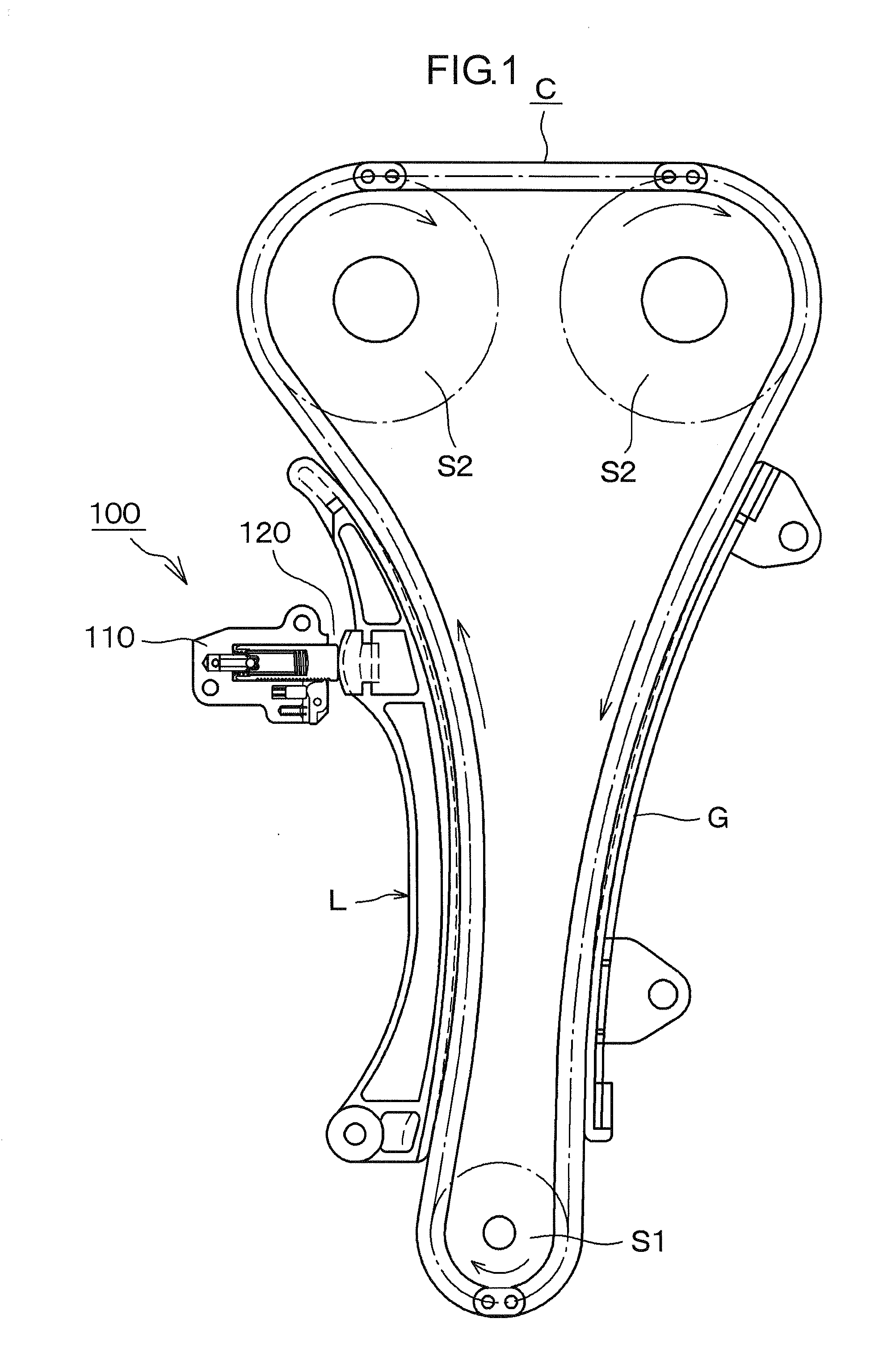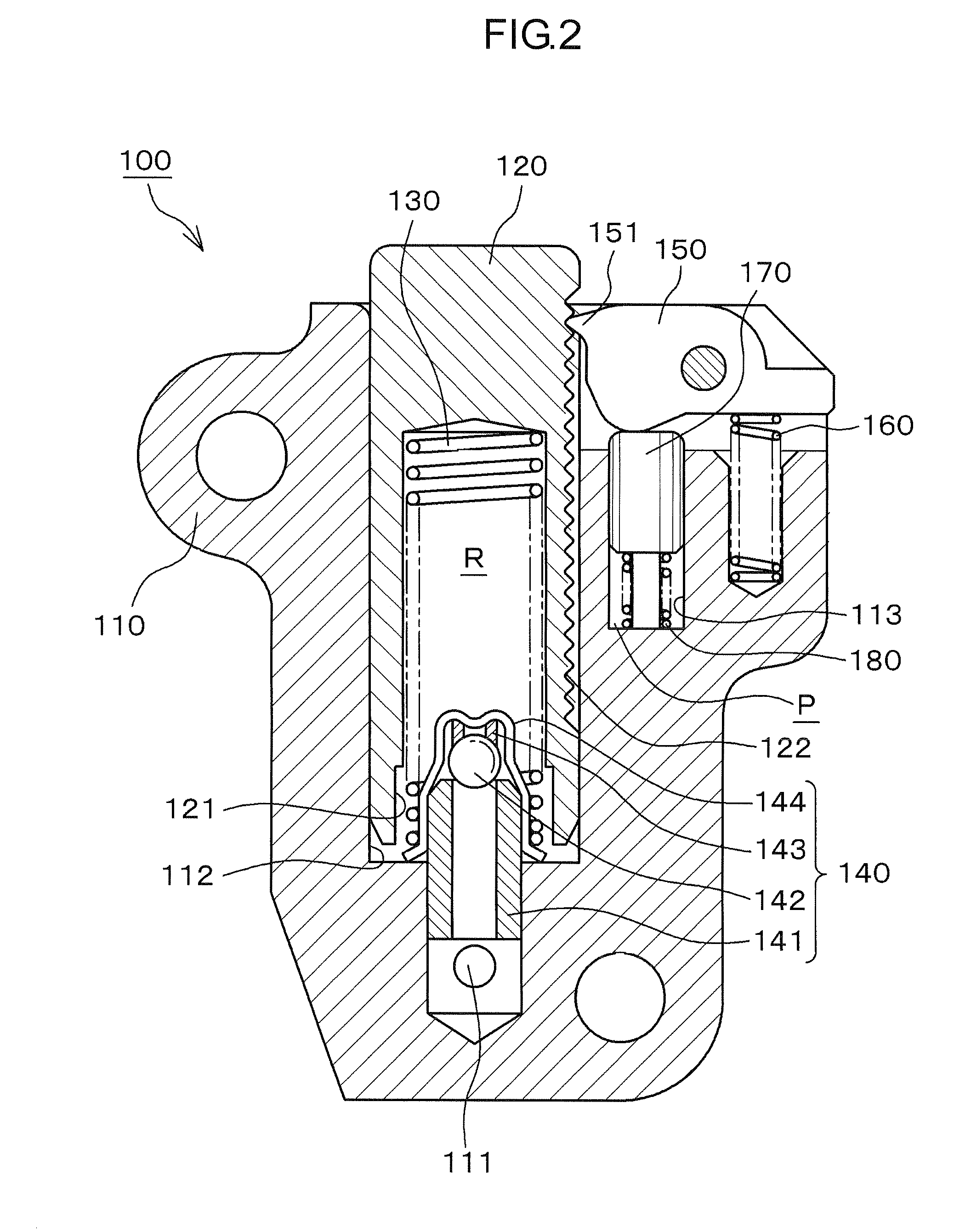Ratchet-type tensioner
a ratchet-type, tensioner technology, applied in the direction of valve drives, machines/engines, gearing, etc., can solve the problems of hydrostatic pressure in the oil chamber 510, breakage of one or more teeth, etc., to prevent excessive biting of the pawl, stable supply of oil, and easy fabrication of passages
- Summary
- Abstract
- Description
- Claims
- Application Information
AI Technical Summary
Benefits of technology
Problems solved by technology
Method used
Image
Examples
first embodiment
[0038]As shown in FIG. 1, a ratchet-type tensioner 100 according to the invention is attached to an engine body adjacent the slack side of a timing chain C, i.e. the span of the chain that travels from a driving sprocket S1 on the engine crankshaft toward one of two driven sprockets S2 on the engine camshafts. A plunger 120, protruding from the tensioner housing 110 moves in and out of the housing to apply tension to the slack side of the timing chain C through a pivoted lever L by pressing the back of the lever at a location spaced from lever's pivot axis.
[0039]The tension side of the chain, i.e., the span traveling toward the crankshaft sprocket S1 from a camshaft sprocket S2, slides on, and is guided by, a stationary chain guide G fixed on the engine body. Arrows in FIG. 1 show the direction of rotation of the sprockets and the direction of movement of the chain.
[0040]As shown in FIG. 2, a first oil supply passage 111 is provided in the tensioner housing for introducing oil suppl...
second embodiment
[0054]the ratchet-type tensioner is tensioner 200, shown in FIG. 6. This tensioner is used in the same manner as the ratchet-type tensioner 100 described above, but is different in that it is provided with an orifice 290 for absorbing pulsations in the oil supplied under pressure from the engine block. Except for the orifice and the extension of the length of the pin-receiving hole in order to accommodate the orifice, the structure is substantially the same as that of the tensioner 100 described above. Accordingly, parts of the ratchet-type tensioner 200 shown in FIG. 6 that are identical with, or correspond to, those of the ratchet-type tensioner 100 are denoted by reference numerals exceeding by 100, the corresponding reference numerals in FIG. 2.
[0055]The orifice 290 controls the amount of the oil under pressure introduced into chamber P of the pin-receiving hole through the second oil supply passage 214, when the amount of supplied oil is excessive. The orifice 290 also controls...
third embodiment
[0057]the ratchet-type tensioner is tensioner 300, shown in FIG. 7. This tensioner is used in the same manner as the ratchet-type tensioner 100 described above, but is different in the disposition and configuration of the second oil supply passage 314 for introducing oil into the chamber P of the pin-receiving hole. In other respects, the structure of tensioner 300 is the same with that of tensioner 100 described above. Accordingly, parts of the ratchet-type tensioner 300 shown in FIG. 7 that are identical with, or correspond to, those of the ratchet-type tensioner 100 are denoted by reference numerals exceeding by 200, the corresponding reference numerals in FIG. 2.
[0058]The second oil supply passage 314, for introducing oil into the oil chamber P of pin-receiving hole 312, is formed in the housing 310 and communicates directly with the high pressure oil chamber R at a location near the bottom of the plunger-accommodating hole 312. The passage 314 is connected to high pressure oil ...
PUM
 Login to View More
Login to View More Abstract
Description
Claims
Application Information
 Login to View More
Login to View More - R&D
- Intellectual Property
- Life Sciences
- Materials
- Tech Scout
- Unparalleled Data Quality
- Higher Quality Content
- 60% Fewer Hallucinations
Browse by: Latest US Patents, China's latest patents, Technical Efficacy Thesaurus, Application Domain, Technology Topic, Popular Technical Reports.
© 2025 PatSnap. All rights reserved.Legal|Privacy policy|Modern Slavery Act Transparency Statement|Sitemap|About US| Contact US: help@patsnap.com



